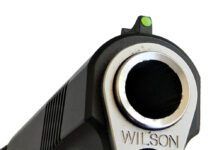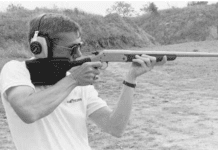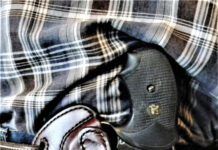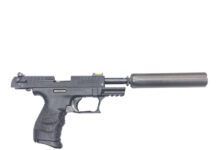I noticed the bolt on the old shotgun was closed when it was being taken out of its case, so I asked the owner to open it. When he touched the bolt, the striker released. I was mighty relieved that he had remembered to unload the piece before bringing it into my shop. Another person standing at the end of the counter, which happened to be at the shotgun’s muzzle end, was even more relieved than I was.
For what it was worth, the gun’s owner assured everyone present that merely touching the bolt had never before released the striker. He’d purchased his Model 58 new in the mid 1950s. Around 1971, it began to develop a tendency to let the striker go when the trigger was pulled with the safety on. He had been able, he said, to control the malfunction by “nursing” the bolt forward or leaving the safety off. By the time he brought the gun to me in 1994, the tendency had become a nasty habit and the insides of the Model 58 were obviously worn to critically dangerous extremes.
Once I had run a few dummy rounds through the piece and had it field stripped on my bench, it wasn’t hard to locate the trouble spots. The Model 58’s safety is located on the right hand side of the receiver. When I slid the bolt home with the safety off, trigger and sear interface was pretty solid and the pull tested out to a slightly mushy 5 pounds. When the bolt was then opened, closed, locked down and the safety moved rearward to its “on” position, the trigger simultaneously pivoted down to all but disengage with the sear. A gentle rap anywhere on the barreled action was all it took to release the striker forward. The pull was less than an ounce. The 58 could have gone off while being shouldered or bumped against a branch. That it had not can only be chalked up to dumb luck.
The wear in the trigger assembly somehow had to be corrected, or the shotgun had to be junked. A new trigger, trigger spring, sear and safety lever would have been the ideal solution, but a few calls to my normally reliable parts sources came up with a zero on availability. Machining the trigger, sear and safety lever from scratch would have run the cost far beyond both the dollar and sentimental value of the gun, so that was ruled out. Instead, I decided on a repair that had worked very well on some other old rifles and shotguns with similar problems. It isn’t a universal cure-all—if there is such a thing—so choose when and where to use it wisely.
On the Model 58, the trigger spring is seated between the trigger and the sear. When the trigger is pulled, the spring is compressed, forcing the sear up to disengage with the trigger hook, which has been pivoted downward. When the trigger is released, the stored energy in the spring pivots the trigger hook upward while easing pressure on the sear and allowing reengagement with the trigger hook. If the safety is moved to its “on” position at this time, it pivots the safety lever down on its pin to block the trigger’s rear extension. This particular Model 58’s trigger spring had been weakened by years of heavy use, and was no longer strong enough to prevent the trigger from pivoting away from the sear when the safety lever contacted the trigger extension. The spring had to be replaced, but how strong was the spring when it was new? My examination of the trigger extension at the point it contacts the safety lever had shown signs of wear and raised another question: Would a stronger spring than the original be needed to (1) help close the gap between the lever and the extension, and (2) apply force enough to hold the trigger firm against the lever’s downward pressure?
If I had known the strength of the original spring, I’d likely have found a serviceable replacement for it in Brownells catalog, but I didn’t. So I sent the old spring, along with my other questions, to Wolff Spring Company in Newton Square, Pennsylvania, the mushroom capital of the United States. Wolff has ways of determining the weight of springs.
A few days later, I received a packet of springs they’d chosen for me to experiment with. Included were two of Wolff’s long, general purpose English springs; two 10-pound Taurus 669 trigger return springs and the original from the Model 58. An accompanying note explained that Wolff could not supply an exact replacement, but that the enclosed springs should be adaptable to the Model 58.
I began the fitting process by counting the coils in the old spring, counting an equal number of coils in one of the English springs and cutting it off at that point. After installing the new spring, I cycled the bolt and moved the safety to its “on” position. The striker released. I cut another chunk out of the English spring, this one a little longer, and tested it again. This time, there was less separation between trigger/sear engagement when the safety was moved to “on” and the striker stayed put. However, the trigger pull had only gained a few ounces and was still too light for a hunting gun.
Next, I tried a 10-pound Taurus spring. After cutting it according to coils and installing it, I gained a safer pull, but the trigger hook was still moving off the sear when the safety lever put pressure on the trigger extension. I took the remaining Taurus spring, cut it two coils longer and managed to hold it in place while I worked in the trigger pivot pin. When I ran the checkout, there was no movement off the sear, so the heavier, over-length spring was part of the solution.
What remained to be corrected was the play between the safety lever and the trigger extension. The extension was worn at the point of contact. With the safety “on,” the lever could be wobbled forward and backward on the extension’s surface. If that wearing process continued, it would have a negative effect on the function of the safety sooner or later. Here’s where things got into a “Catch 22” mode. The safety lever’s pressure on the trigger extension was causing disengagement between the sear and trigger and had been corrected with a heavier spring. Would improved contact between the extension and the lever recreate the problem, and require a still heavier spring? And could such a spring even be fitted to the gun?
I considered three ways to raise the worn area on the trigger extension’s surface: build it up with silver solder, insert a pin in it, or take a prick punch to it. The trigger on this Model 58 appeared to be case hardened, so I didn’t want to heat it up. Drilling and inserting a pin of drill rod in the extension, then filing/grinding it down was a definite possibility, but I decided to try the punch first. If that didn’t work, I could always put in the pin. After locking the trigger in a vise, I raised one dimple on the extension. It wasn’t enough to take the play out of the safety lever, so I raised another dimple just to the rear of the first one. Two dimples later, there was good contact, no slop, no need to worry about a heavier spring and no more safety problems. After that, to clean up the mushy trigger pull, I polished the trigger/sear interfaces.
Not high tech, but dimples I raised for similar reasons on the trigger mechanisms of old guns half a dozen years ago are still holding up.


























